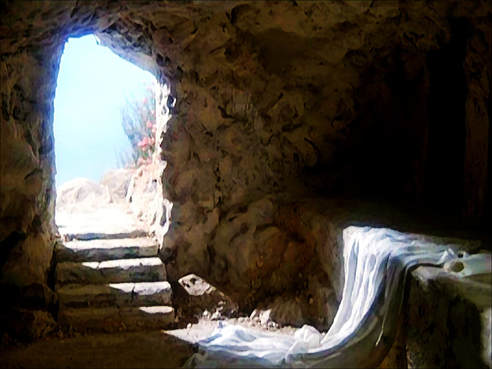|
4/24/2019 1 Comment Article II - The ResurrectionHistorical Fact I - The Empty TombHow do we know Jesus rose from the dead? In this article, we will focus on the "minimal facts" strategy, made popular by Gary Habermas and William Lane Craig. First, we will look at a small number of facts on which virtually everyone agrees. This consensus of agreement on historical facts includes Christian, atheist, and agnostic experts. Second, we will ask what best accounts for these historical facts and most fully explains them. This process is called inductive reasoning. Inductive reasoning begins with a few known facts and uses reason to discover the best possible explanation. Science and criminal court-cases use this type of reasoning -- the facts are put forward, and the jury has to decide the best explanation of those facts.
Virtually all historians recognize that Jesus of Nazareth was crucified and killed by Roman leaders in Jerusalem around 2,000 years ago. What happened after Jesus' crucifixion is the controversial question. Generally all scholars accept three historical facts: the empty tomb, the appearances of Jesus after his death, and the sudden origin of Christianity. The overwhelming majority of historians, believers and unbelievers alike, agree on these three facts. Historians may disagree on what best explains these facts, but they agree that these are historical facts. First, how do we know that Jesus' tomb was found empty? Here are a four reasons we can know that Jesus' tomb was found empty. The first line of evidence is the early eye-witness accounts of the empty tomb. We have no less than six independent accounts of Jesus' burial and the empty tomb. Historians think they have hit the jackpot if they have two independent accounts of the same event, we have six. Two of the sources, scholars believe, date back to within 5-10 years of Jesus' death -- Mark's passion narrative and 1 Corinthians 15 -- exceptionally early. Mark's passion narrative is part of ancient source material he has used in writing his gospel. Mark's gospel is composed of brief snapshots of the life of Jesus and can seem loosely connected and not always chronologically arranged. The passion narrative, on the other hand, is a smooth, continuously-running narrative. Scholars consider Mark's gospel the earliest gospel and this passion narrative is one of Mark's sources and is therefore even earlier. When we compare all of the passion narratives in the gospels, they do not diverge until after the burial. The story is simple and lacks signs of legendary development. Mark does not embellish it with theological motifs. The simplicity is an excellent reason to trust it, according to scholars. A second reason to believe in the empty tomb is that Jesus' burial is an ancient tradition quoted by St. Paul in 1 Corinthians 15: "For I delivered to you as of first importance what I also received, that Christ died for our sins in accordance with the Scriptures, that he was buried, that he was raised on the third day in accordance with the Scriptures, and that he appeared to Cephas, then to the Twelve" (1 Cor 15:3-5). Paul uses typical rabbinical terms "received" and "delivered" to describe what he is handing on, and these verses are a highly stylized four-line formula that lacks Pauline characteristics. This tradition most likely dates back to around A.D. 36, when he visited Jerusalem and spent two weeks with Cephas and James (see Galatians 1:18). The short time span and personal contact with Jesus' apostles place it within five years of Jesus' death, which makes it impossible to cast as mere legend. The third line of evidence is the women witnesses. First-Century Jewish society regarded women's testimony as not credible; courts would not permit their testimony. In this context, if you were to make up a story, you would not use women as the protagonists. If it were a legend, you would use the male disciples as the primary witnesses. The fact that women appear first at the tomb, in all of our accounts, suggests that whether the authors liked it or not, they recorded this fact because that's the way it happened. The fourth line of evidence is the early attempts of the Jewish authorities to disprove the empty tomb. St. Matthew relates that the religious leaders made up a story, accusing Jesus' disciples of stealing Jesus' body (see Mt 28:15). The Jewish leaders' response to the disciples' proclamation of Jesus risen from the dead was not to point to the occupied tomb and laugh at them but to claim that they took Jesus' body from the tomb. The very opponents of the early Christians, then give supportive evidence of the empty tomb. These reasons when taken together explain why the overwhelming majority of historians and scholars today agree that Jesus' tomb was discovered empty after his burial. In the next post, we will cover the second historical fact, Jesus' appearances after his death. Resources: William Lane Craig: https://www.reasonablefaith.org Gary Habermas: http://www.garyhabermas.com Brandon Vogt: www.ClaritasU.com
1 Comment
Leave a Reply. |
AuthorI am a Catholic priest writing about Catholic things. Archives
May 2019
CategoriesAll Advent Almsgiving Ash Wednesday Catholic Charity Christmas Confession Discipleship Divine Mercy Eternal Life Explaining Facts Faith God Greatest Story History Holiness Holy Mass Hope Jacques Philippe Jesus Kingdom Of God Lent Lord Love Lust Nativity Of The Lord O Antiphons Pope Benedict XVI Prayer Resurrection Of Jesus Spiritual Life St. Faustina St. John Paul II St. Thomas Aquinas Temptations Temptations Of Jesus Trust Year Of Mercy |

 RSS Feed
RSS Feed